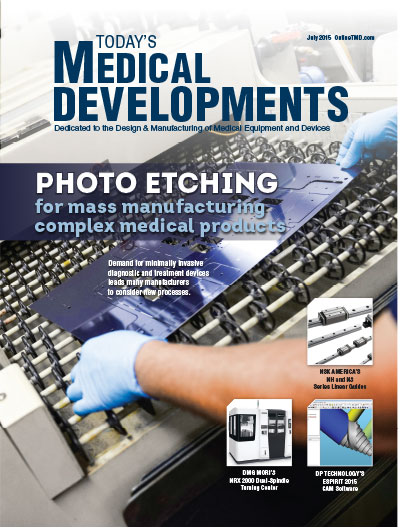 DWH Systems Inc. of Seminole, Florida, and Mumbai, India-based ELAN Vascular Technologies worked together to design and manufacture a system for real-time optical coherence tomography (OCT) guidance of a femtosecond ablation laser. OCT is a medical imaging method that uses light to capture micrometer-resolution, three-dimensional images from within biological tissue. The device incorporates low-coherence interferometry of near-infrared light. Long wavelength light allows it to penetrate into the scattering medium with up to sub-micrometer resolution.
DWH Systems Inc. of Seminole, Florida, and Mumbai, India-based ELAN Vascular Technologies worked together to design and manufacture a system for real-time optical coherence tomography (OCT) guidance of a femtosecond ablation laser. OCT is a medical imaging method that uses light to capture micrometer-resolution, three-dimensional images from within biological tissue. The device incorporates low-coherence interferometry of near-infrared light. Long wavelength light allows it to penetrate into the scattering medium with up to sub-micrometer resolution.
Design & procedure
The DWH Systems device performs micro-ablation on the outer surface of diseased arteries. OCT first acquires a 3D C-scan map of the diseased portion of an artery then develops an ablation map for the system to follow. As ablation is performed, OCT monitors the laser’s cutting process from multiple angles in real-time. This allows the system to verify the proper and safe depth of cut for the prescribed procedure.
 After each ablation pass, the system generates a new C-scan map. The procedure is repeated until the desired vessel wall thickness has been achieved, allowing the vessel to expand to normal inner wall diameters restoring blood flow. This technique eliminates the need for stents by treating the disease instead of temporarily easing its conditions.
After each ablation pass, the system generates a new C-scan map. The procedure is repeated until the desired vessel wall thickness has been achieved, allowing the vessel to expand to normal inner wall diameters restoring blood flow. This technique eliminates the need for stents by treating the disease instead of temporarily easing its conditions.
Using ELAN’s specifications, DWH was able to carry out the complete design, development, and fabrication of the laser ablation system. During the engineering process, DWH’s designers choose system components that either met or advanced very strict performance specifications.
High-precision machining
The company selected the high-precision Steinmeyer MT84, 50mm translation stage, with an H4 ceramic motor and mercury linear encoder to provide the speed and accuracy necessary for the project. To drive such a tightly engineered stage, the company selected the AllMotion EZPZ23-HR controller board because of its ease-of-use and reliability.
Designed for rapid implementation of position control using nanomotion piezoelectric motors, the controller measures 2.25" x 2.25" x 0.962", operates from any 11V to 13V, 2A input as a PC controlled or standalone unit, and it can control up to 16 drives daisy-chained together. The device communicates across an RS485 port and is compatible with Cavro DT or OEM protocol. It can also use the EZCommander Windows application or a serial terminal program such as HyperTerminal to issue commands. The EZPZ23-HR also accepts two opto-electronic, two mechanical switch inputs, four mechanical switch inputs, and ADC inputs with up to 10 bits accuracy.
 “We liked the low-level control afforded us by the command interface structure of the EZPZ23-HR,” says Doug Hamilton, president and chief engineer of DWH Systems. “Not having to burden the OCT system platform with a large utility application for command interpretation was a welcome benefit for the system’s operational environment. Further, the ability to string commands and pre-build a command structure that could then be fired when needed was extremely valuable to our project needs.”
“We liked the low-level control afforded us by the command interface structure of the EZPZ23-HR,” says Doug Hamilton, president and chief engineer of DWH Systems. “Not having to burden the OCT system platform with a large utility application for command interpretation was a welcome benefit for the system’s operational environment. Further, the ability to string commands and pre-build a command structure that could then be fired when needed was extremely valuable to our project needs.”
The final system required a repeatability of 10µm with a velocity range of 0.25mm/sec to 10mm/sec and total travel was the full 50mm of the translation stage. In addition to implementing imaging system algorithms used for real-time vascular wall thickness detection and analysis, the company had to integrate four different motion control sub-systems, which included a stepper motor, three synchronized servo motors, the translation stage HR4 ceramic motor, and a 6-axis robot arm.
The design team was faced with the integration of the three HD digital video cameras, three OCT imaging heads, one femtosecond ablation laser, three 532nm guide lasers, one 632nm guide laser, 132 I/O points, two primary computer systems, and more than 350,000 lines of code.
DWH Systems machinists have been working on motion control projects for more than 25 years, and have enjoyed the ease of designing and working with the EZPZ23-HR.
After some initial debugging and upgrading of their system, the company’s engineers werre able to certify the controller to their specification needs.
“During the verification process, AllMotion’s technical staff supported all of our needs and addressed all of our concerns with immediate action,” Hamilton says. “They even provided custom upgrades to meet a particular problem we were experiencing.”
AllMotion
www.allmotion.com
DWH Systems Inc.
www.dwh-systems.com

Explore the July 2015 Issue
Check out more from this issue and find you next story to read.
Latest from Today's Medical Developments
- Lumetric's Scanning Tubing Measurement System
- Latest advancements in machine tool technology
- Visit Okuma America at IMTS 2024
- March 2024 USMTO orders were $354.7 million
- AM for Aircraft Cockpit Interior Components
- Arizona WearTech Center member receives new patent
- SABIC showcased progress in plastic innovation
- Ink for 3D-printing flexible devices, no mechanical joints





